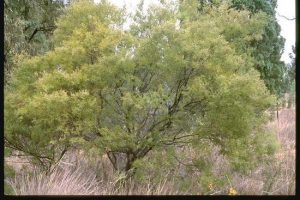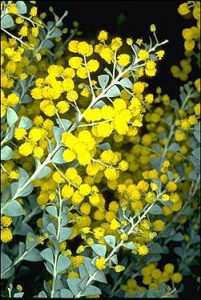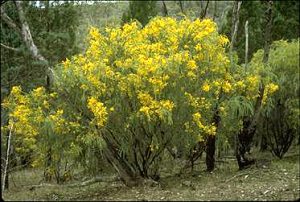Eight wattles “alien” to the ACT (and region) might become weeds and some show a propensity to naturalise within reserves and other native bush areas. Native plants they may be, but are they OK when viewed in the light of the now known issues of weediness of another old favourite – Cootamundra Wattle?
Our committed and passionate government weed officers, through careful long-term strategic planning, and despite fluctuating weed budget allocations, have initiated some of the best weed mapping and focused weed management programs in Australia, with priorities on suppressing and containing weeds that are Declared Pest Plant species in the ACT, listed under the Pest Plants and Animals (Pest Plants) Declaration 2015 (No 1), focusing on maintaining our nature reserves and other natural assets as weed free as possible.
However, in addition to those Declared Pest Plants, there are many other introduced ‘weeds’ that occur in the ACT. While most of these species originate from other countries, there are some Australian wattle species alien to the ACT that have become naturalised (an exotic or non-local native plant that can reproduce and sustain itself without human assistance). The Census of Plants of the Australian Capital Territory -version 4 (Centre for National Biodiversity Research 2017) has identified a number of Exotic Australian (EA) species that either have become, or may become, naturalised (i.e. doubtfully naturalised (DN) at present). For some of these species, management may not currently be considered a priority, and indeed sometimes they are considered of benefit (e.g. providing excellent bird habitat). Others are widespread and may be, or are, impacting indigenous biodiversity. The best-known species that is naturalised in ACT and the region and is a Declared Pest Plant species is Cootamundra Wattle –Acacia baileyana.
Community views can differ on the recognition of “native” species as weeds. Some have leanings toward it being …better to have native weeds than exotic weeds, as they blend in and fauna is adapted to them, and that native weeds …will blend into new ecosystems over time. Despite the many arguments that can be made on or about these views, in this article we wish to deal with a number of alien wattle species in the ACT and region. So, in reading on, ponder on the history of the introduction and performance of Cootamundra Wattle in our local region (and in other States) before coming to any conclusion!
At present the Census of Plants of the Australian Capital Territory -Version 4 (Centre for National Biodiversity Research 2017) lists 27 species of Acacia that are identified as ‘Exotic Australian’ in the ACT. Four species are listed as indigenous to the ACT, but populations are establishing outside their original range: Acacia dawsonii, A. melanoxylon, A. pycnantha and A. rubida. Four have established naturalised populations: A. baileyana, A. boormanii, A. decurrens and A. longifolia subsp. longifolia. There are 17 species that are doubtfully naturalised (DN): A. cardiophylla, A. cultriformis, A. dealbata × decurrens, A. elongata, A. extensa, A. falcata, A. fimbriata, A. flexifolia, A. floribunda, A. howittii, A. lunata, A. saligna, A. stricta, A. subulata, A. venulosa, A. vestita and A. viscidula. Two are identified as formerly naturalised (FN): A. baileyana x decurrens and A. terminalis (no naturalised populations are known to occur in ACT).
The “exotic Australian” wattle species for which there are now signs of potential future weed issues are the following:
| SPECIES | STATUS | COMMENTS |
A. boormanii |
EA | Hails from the upper catchment of the Snowy River, from Cooma to the Victorian highlands. It grows on rocky slopes and along creeks in sandy and gravelly soils (Florabank 2017). It has been widely cultivated in gardens and in public and roadside plantings in the ACT for its hardiness and prolific winter/spring flowering. It readily regenerates around parent plants. It has become naturalised on poorer sites. At this stage removal is warranted, at least in reserve areas. |
A. cardiophylla |
EA, DN | Hails from Gilgandra south and west to Wagga Wagga and Lake Cargelligo area. This species has naturalised on Central Coast and Southern Tablelands from garden escapes (PlantNET 2017a). This species has primarily been used in gardens in the ACT and region as an ornamental. While currently regarded as “doubtfully naturalised” (Centre for National Biodiversity Research 2017), indications are that it is naturalising in disturbed sites and in bushland areas in the local region. Needs monitoring. |
A. cultriformis |
EA, DN | Hails from Wagga and west from the Denman-Singleton district, common on the Western Slopes. This species is often cultivated, sometimes naturalised (PlantNET 2017b). Grown widely in cultivation and its hardiness as public planting/roadside plantings on hard sites. Currently regarded regionally as “doubtfully naturalised” (Centre for National Biodiversity Research 2017), but is sparingly naturalising near existing plantings. Needs monitoring. |
A. fimbriata |
EA, DN | Found primarily in coastal districts north from Nerriga and west to Inverell and is widely cultivated (PlantNET 2017c). Widely used in cultivation in our region, primarily as garden plants or in suitable moister sites of public area plantings. Currently regarded as “doubtfully naturalised”, but is showing a tendency to spread to moderately poor sites. Needs monitoring. |
A. floribunda |
EA, DN | Extends from coastal sclerophyll communities, westward to the Rylstone area, in sandy alluvial soil and along watercourses (PlantNET 2017d). Widespread in cultivation regionally, and is adapting to harder, poorer and drier sites. Currently regarded as “doubtfully naturalised” but is now being observed to spread to moderately poor sites near and in reserve areas. At this stage monitoring can continue but removal is probably warranted, at least in reserve areas. |
A. longifolia subsp. longifolia |
EA | This species is common on Coast and Tablelands in sclerophyll communities and coastal heath and scrub, including sand on foredunes (PlantNET 2017e). Widespread in cultivation regionally, and adapts to harder, poorer and drier sites. This species is now being observed to spread to moderately poor sites near and in reserve areas which has been used in many regional freeway plantings and is gradually spreading. At this stage monitoring can continue but removal is probably warranted in reserve areas. |
A. pravissima |
A. pravissima is chiefly on the ranges south from the ACT and east to the Coolumbooka Nature Reserve near Bombala, and grows many soil types on hillslopes, ridges and riverbanks (PlantNET 2017f). This species is found naturally in the ACT’s western ranges, but probably did not occur naturally further east than the Murrumbidgee area. Because it occurs in the ACT, the ACT Plant Census (Centre for National Biodiversity Research, May 2012) does not comment on its naturalisation status. It has been used widely in domestic gardens and public plantings. It is a very hardy species that has readily adapted to many sites in the ACT and region. This species appears to be spreading more quickly in the region than other species, and is probably the most urgent “introduced” wattle for management in and near lowland reserve and bush areas. | |
A. vestita |
EA, DN | Widespread in the Wellington, Mudgee, Forbes, Bathurst to the Cowra area in dry sclerophyll forest, often on steep slopes or sheltered gullies, with dubious records from near Bega in 1891 and from Bombala district in 1901; widely cultivated, occasionally naturalised (PlantNET 2017g). Currently regarded as “doubtfully naturalised” but this species appears to be gradually spreading from domestic cultivation/public plantings. At this stage monitoring should continue but removal is probably warranted in reserve areas. |
The above information on the potential weediness of eight wattles “alien” to the ACT (and region) has been based primarily on observation over a number of years, and reference to observations recorded on Canberra Nature Map. It could not be said that any of the species should take priority for removal, though Acacia boormanii, A. cultriformis, A. floribunda, A. longifolia subsp. longifolia and A. pravissima are showing a propensity to naturalise within reserves and other native bush areas. Native plants they may be, but are they OK when viewed in the light of the now known issues of weediness of another old favourite – Cootamundra Wattle?
The authors would appreciate your views on these wattles – please send any comments to email gbu22182@bigpond.net.au and/or sarahsharp@grapevine.net.au
Authors: Sarah Sharp & Geoff Butler, January 2018
REFERENCES
ACT Govt. 2017. 2016/17 Environmental Weeds Program – end of financial year report (p4). Steve Taylor (ACT Senior Weeds Officer)
Centre for National Biodiversity Research 2017. Census of Plants of the Australian Capital Territory –Vascular Plants Version 4.
Florabank 2017. Fact Sheet – Acacia boormanii. http://www.florabank.org.au/lucid/key/species%20navigator/media/html/Acacia_boormanii.htm
PlantNET 2017a. Acacia cardiophylla A.Cunn. ex Benth. http://plantnet.rbgsyd.nsw.gov.au/cgi-bin/NSWfl.pl?page=nswfl&lvl=sp&name=Acacia~cardiophylla
PlantNET 2017b. Acacia cultriformis A.Cunn. ex G.Don. http://plantnet.rbgsyd.nsw.gov.au/cgi-bin/NSWfl.pl?page=nswfl&lvl=sp&name=Acacia~cultriformis
PlantNET 2017c. Acacia fimbriata A.Cunn. ex G.Don http://plantnet.rbgsyd.nsw.gov.au/cgi-bin/NSWfl.pl?page=nswfl&lvl=sp&name=Acacia~fimbriata
PlantNET 2017d. Acacia floribunda (Vent.) Willd. http://plantnet.rbgsyd.nsw.gov.au/cgi-bin/NSWfl.pl?page=nswfl&lvl=sp&name=Acacia~floribunda
PlantNET 2017e. Acacia longifolia (Andrews) Willd. http://plantnet.rbgsyd.nsw.gov.au/cgi-bin/NSWfl.pl?page=nswfl&lvl=sp&name=Acacia~longifolia
PlantNET 2017f. Acacia pravissima F.Muell. http://plantnet.rbgsyd.nsw.gov.au/cgi-bin/NSWfl.pl?page=nswfl&lvl=sp&name=Acacia~pravissima
PlantNET 2017g. Acacia vestita Ker Gawl. http://plantnet.rbgsyd.nsw.gov.au/cgi-bin/NSWfl.pl?page=nswfl&lvl=sp&name=Acacia~vestita
